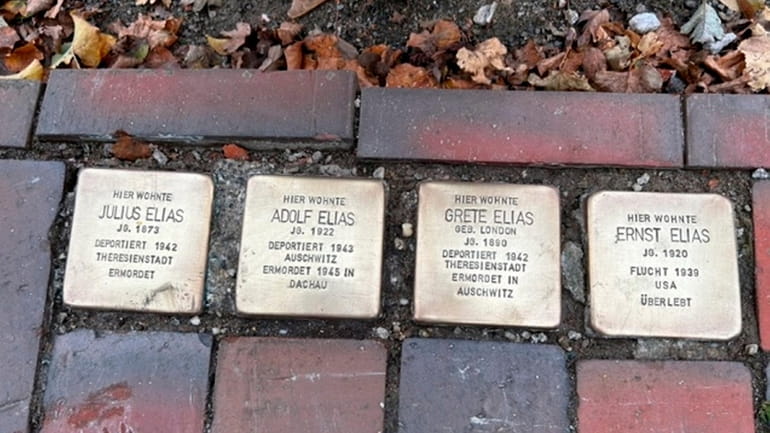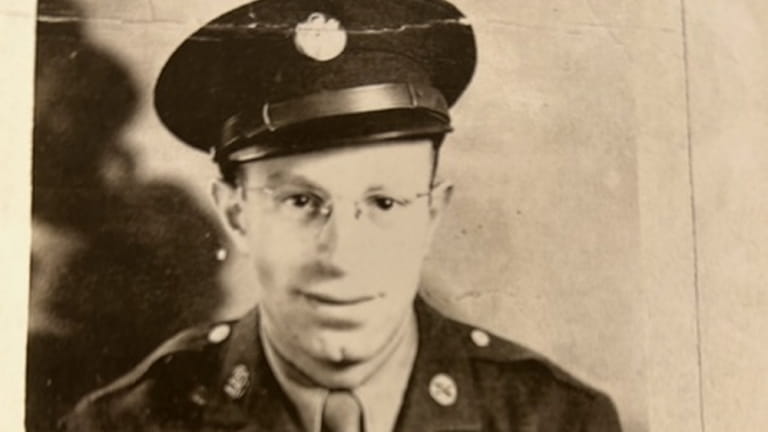My Turn: Finding steps toward forgiveness in Germany

So-called stumbling stones have been embedded in the street in Hoya, Germany, near the last-known freely chosen home of Joan Herman’s family members, most of whom died in the Holocaust. Credit: Joan Herman
How do you ask forgiveness for the unforgivable? In the October issue of our temple newsletter, Hakol, our spiritual leader, Rabbi Beth Klafter, wrote about the 10 days between Rosh Hashanah and Yom Kippur as a time of teshuva, a period of reflection and repentance. During that month, my daughter, Elizabeth and I traveled to Germany, where we witnessed sincere acts of teshuva.
We were guests of Heike and Hans Huth, residents of Hoya, a tiny town of 3,800 in northern Germany, where my father, Ernest Elias, was born in 1920. Hoya is where the Elias family had lived for generations, and where Ernest’s father (my grandfather Julius) was a prosperous owner of a dry-goods store.
The Huths, who are not Jewish, as well as many other residents of Hoya, have made it their mission to honor the memory of the Jewish residents who were murdered in the Holocaust. In the 1930s, Hoya was home to 10 Jewish families; after the war, members of only three families survived, all of whom immigrated to the United States.
My father was one of more than 30,000 Jewish men arrested Nov. 9-10, 1938, during Kristallnacht, or the Night of Broken Glass, when the Nazis smashed windows and ransacked hundreds of Jewish businesses, buildings and synagogues. My father was eventually released and in 1939 became the only member of his family to obtain a visa allowing him entry to America. His younger brother and parents perished in concentration camps.
Although Hoya’s current residents either were not yet born or were small children during the Nazi era, the community has tried to follow teshuva principals, set forth by Maimonides, to accept its responsibility for the harm caused to others, sincerely apologize for the misdeeds of the German people, and focus on change and making different choices in the future. All of this, to quote Rabbi Klafter, “takes time and a depth of reflection and emotional work.”
The “stumbling stones,” memorial stones to victims outside their last know home, are embedded in the streets of Hoya; the Jewish cemetery that was desecrated by the Nazi soldiers has been restored and is cared for; the synagogue, destroyed on Kristallnacht, is being turned into a park and includes a sign to remind visitors what hate can do; perhaps most important for the future, German schoolchildren are required to learn about (and hopefully, from) their history. A formerly vacant store is a small museum for residents so they will “never forget” the lives that were lost.
Fortunately, Hoya is not alone in this undertaking, as other small towns and cities in Germany have reached out to descendants and taken up the mission of teshuva. My daughter and I also toured Jewish sites in Berlin, but none moved us more than the government-sponsored Memorial to the Murdered Jews of Europe. (By using the word “murdered,” Germany as a nation officially admitted to a crime.) The 2,711 coffin-shaped pillars cover an entire block in the city center.

Joan Herman’s father, Ernst Elias, when he served in the U.S. Army in 1945, after he immigrated to the United States. Credit: Herman Family
There may be unintentional irony in the location of the memorial, in full view of the windows of the U.S. Embassy. Those who have watched the recent Ken Burns documentary “The U.S. and the Holocaust” may find the memorial’s location especially appropriate, as we in this country bear responsibility for our refusal to admit more Jewish refugees during the Holocaust. My father was the only member of his family to escape Germany because the United States severely limited visas, even after Hitler’s genocide agenda became clear to everyone in this country.
If we learned anything during our visit to Germany and Hoya, it is that, as Rabbi Klafter said, “the gates of teshuva are always open. Everyday is an opportunity for us to grow and change for the better.”
We returned home with the hope that the people of Germany, as well as we in America, will embrace and practice the steps to achieve teshuva.
Joan Herman,
Melville
YOUR STORY Letters and essays for My Turn are original works (of up to 600 words) by readers that have never appeared in print or online. Share special memories, traditions, friendships, life-changing decisions, observations of life or unforgettable moments for possible publication. Email act2@newsday.com. Include name, address, phone numbers and photos if available. Edited stories may be republished in any format.
